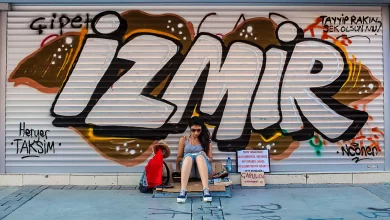
Bitlis City, Türkiye
Bitlis (or Bidlis) is a city in the Kurdish region of Türkiye. It is only 15 kilometers away from Lake Van and is located on the Bitlis River, one of the Tigris River branches. The city has six districts: Hizan, Mutki, Ahlat, Adilcevaz, Tatvan, and Güroymak.
Getting to know Bitlis Türkiye
Bitlis is a city in the Kurdish region of Türkiye. It is only 15 kilometers away from Lake Van and is located on the Bitlis River, one of the Tigris River branches. The city has six districts: Hizan, Mutki, Ahlat, Adilcevaz, Tatvan, and Güroymak.
The area where Bitlis is located includes the eastern corner of Dasht Moush, the plateau west of Lake Van, and the wild and mountainous country on both sides of the city of Bitlis. The climate of this mountainous region is harsh, with long winters, heavy snowfall, and hot summers. Agricultural products of Bitlis include fruits, grains, and tobacco, although this city is more famous for the leather industry, production of tobacco products, weaving and dyeing, and carpentry.
Built on a deep valley, Bitlis is a natural crossroads on the historic Silk Road. Throughout history, this city has been home to many civilizations, including Urartians, Assyrians, Persians, Macedonians, Romans, Seljuks, Ilhanli, and Ottomans. Before the Kurds occupied Bitlis, it was one of the most important cities in the Kingdom of Armenia. It housed a large fortress that served as the junction point for the historic Armenian region of Arzanene.
In the 12th to 13th century, this city was conquered by the Kurds, and until the 19th century, it was known as the medieval capital of the “Prince of Bitlis.” At the beginning of the 19th century, Bitlis was home to about 12,000 people – half Muslim and half Christian. However, by the end of the century, this population had increased to 30,000, and a large population of Armenians immigrated to the city, most of whom unfortunately perished in the Armenian Genocide in 1915.
Bitlis sights
Seljuk Cemetery (Ahlat Cemetery)
Undoubtedly, Ahlat Masha’ar Cemetery is considered the most popular attraction of Beitlish city, and this cemetery, which has about 9000 graves, is the largest ancient cemetery in the Islamic world and Anatolia. This cemetery dates back to the 11th to 16th centuries AD and contains four types of graves: built tombs, prismatic coffins with or without capitals, and funnels. On the tombstones of this collection, you can see information about the deceased, as well as stone inscriptions, literary words, Quranic verses and traditions, the name of the master who made the tombstone, and decorations with letters and geometric shapes. Ahlat tombstones are registered in the UNESCO World Heritage List under the title “Ahlat Tombstones of Urartian and Ottoman Citadels.”
Copulas
In Bitlis and Ahlat, many domes dating back to the Seljuk and Ilkhanid periods are outstanding in their decorations and architectural design. They are the best examples of Seljuk tombs. Domes, known as mausoleums, are usually two-story buildings with a burial chamber below and a chapel above.
Be sure to visit Çifte Kümbet (Twin Cupola), Güpol (Usta Şagirt Türbesi), Emir Bayındır and Hasan Padişah on your trip to the cupolas.
Bitlis Castle
Bitlis Castle was built by Badlis, one of Alexander the Great’s commanders, in 330 BC. It has a perimeter of 2800 meters, a height of 56 meters, and walls with a thickness of 7 meters! According to old narratives, the castle, divided into two upper and lower parts, included 300 houses, a caravanserai and a mosque in the upper castle, a covered market, and several hundred houses in the lower castle!
Ahlat Museum
The museum was opened in 1971 and functions as a local museum, as it is the only museum in the region. It attracts the attention of archeology and history enthusiasts by displaying prehistoric and ancient works from the Urartians and the Paleolithic era.
Batlis Ethnographic Museum
The Ethnographic Museum of Bitlis, located in the city center, exhibits works that show the lifestyle of local people and the social, religious, technical, scientific, and cultural characteristics of different eras of Bitlis.
Ahlat beach castle
Ahlat Beach Castle, which was built by the architect Sinan on the order of Suleiman the Great on the way back from the third Ottoman and Safavid war, is a rectangular castle by the lake with relatively low walls and 13 towers, which has two historic mosques and several houses inside.
The center of the historic city of Bitlis
Located in a valley of historical monuments, Bitlis city center is a popular destination for local and international tourists with its architectural style and mystical atmosphere. The center of Bitlis is like an open-air museum that houses many historical monuments.
El Amman Caravanserai
El Amman Caravanserai, located on the Bitlis-Tatwan highway and the ancient Silk Road route, is an Ottoman building dating back to the 16th century. Built by Huseru Pasha, the governor of Van, it is the largest caravanserai in Anatolia.
Bitlis houses
Bitlis is a city that has become famous for preserving its medieval architecture. Bitlisi houses were built of uniform stones with compacted earthen roofs. The crowned gates of these houses, creating a relatively static feeling from the outside, suggest that the real secret lies within. Bitlis houses are like gates to a vast world that opens to human features with tiled patios and gardens full of fruit trees.
Floor castle
It is on the mountain floor near Adilcevaz. The Urartos built this fort, which dates back to the 9th century BC, and only remnants of the fort remain.
Zal Pasha Mosque
This mosque, named after Zal Pasha Wazir Suleiman Azam, is next to Lake Van on Ahlat-Edilsuaz road. It is made of local stone (Ahlat) and has 12 domes!
İhlasiye School
This school, located in the city’s center, was built by the Seljuks in 1589. It is a masterpiece of Seljuk architecture, standing out with rich patterns and decorations on its walls.
White Church in Mutki
This church is located in the year 900 on a slope in the village of Ikizler in the Mutaki region. This structure was used as a monastery where priests were trained, and today, only the ruins of this building remain.
Nimrod ski resort and cable car
Since Bitlis has long winters, it has great potential for winter tourism. Nimrod ski resort, which is one of the most extended ski resorts in Turkey, is the best example of that. Also, the Nimrod cable car allows visitors to enjoy the relaxing view of Lake Van on one side and Lake Nimrod on the other.
Popular Bitlis dishes
The basis of cooking in Bitlis is meat, fish, and semolina. Also, edible wild plants of the region complement food dishes. Although Buryan (small pieces of lamb or goat meat slowly cooked in deep ovens) is the most famous meat dish in Bitlis, Kibeh is the most popular dish in the city among locals and foreign tourists.
Interestingly, Bitlis is one of the oldest beekeeping centers in Türkiye and the world. This province is famous for having goon and thyme honey. Karakovan Bitlis is world-renowned for its unique characteristics. This honey is made from the nectar of native plants that grow at an altitude of 2500 meters, giving the honey a delicious taste.
Bitlis restaurants that you should try:
- Başhan büryan cafe kahvaltı
- Muhittin Usta’nin Yeri
- Pasahan Kahvaltı & Restaurant
- Azmi Ustanin Yeri
- Büryancı Vahit Ustanın Yeri
- Pinar Buryan Salonu
- Büryancı Azmi’nin Yeri
- Bitlis Buryan Salonu
- Vera Cafe Güzelbahçe

Don’t miss the natural sights of Bitlis
Bitlis province is one of the most mountainous regions of the Eastern Anatolia region, so 71% of this province is mountainous regions. Nimrod and Sofan mountains, which are among the most essential volcanic peaks in the world, are located in Bitlis province.
Sufan Mountain, located east of Bitlis province, is the third highest mountain in Turkey, with a height of 4058 meters. It is an excellent destination for camping and mountaineering enthusiasts. This mountain is located west of Lake Van and has an immense volcanic lake with a crater diameter of 400 meters.
Mount Nimrod, located in the north of the province, is the last extinct volcano in Türkiye. Mount Nimrod, whose highest peak reaches 2935 meters, used to be at a height close to Mount Sufan, but due to explosions and various stages of formation, it was reduced to its current height. Mount Nimrod, which is located in Tetovan City, is the most important natural capital of Bitlis province in terms of tourism capacities.
On the mouth of the mountain, you can find Lake Nimrod, which is the second largest volcanic lake in the world, and enjoy the unique scenery it shows you in summer and winter. In addition to Nimrod Lake, there are five other lakes of different sizes in the Nimrod Caldera, which are surrounded by steep and high mountains and provide visitors with the opportunity to do any water sports and water activities. The caldera also has hot springs, fumaroles, and ice caves and annually hosts many visitors worldwide.
Where is the habitat of bitlis birds?
Three significant bird habitats are located around Lake Van in the foothills of Mount Sofan Bitlis. All of them are protected and registered areas that attract everyone’s attention with their beauty and uniqueness. These settlements are famous for the native and rare species of plants and birds.
The best beaches and lakes of Bitlis to spend time
- Lake One and Cable Wakeboard
- Bitlis beaches of Van Lake
- Nasik Lake
- Nimrod Crater Lake
- Aryan Lake
- Aygir Lake
- Bodakli hot springs
- Mineral waters of Yalan Diriltan
- Gümüşkanat waterfall
What should we bring as a souvenir from Bitlis?
Bitlis has a unique tradition in handicrafts, especially carpentry. The best examples of carpentry in this region are products with a geographical indication made from local walnut trees. Sticks decorated with carving art are ubiquitous and prevalent among these products. It takes about two years of patience to make each of these sticks, which have Seljuk and Ottoman motifs, and they are undoubtedly the best souvenirs to remember this lovely city.
Take part in the cultural events of Bitlis

The night of Arafah or the night of mysticism
The Night of Arafah, or the Night of Mysticism, is an entertainment event that involves gathering people to talk and listen to music. These events are organized especially during long and cold winter nights and provide a good opportunity for socializing and bonding.
Listening to the sound of badges
The Dang Bij song is part of Bitlis province’s cultural heritage, which includes storytelling, religion, poetry, and music. In Kurdish, deng means sound, and bij means speaker. Deng Bijs are oral storytellers who narrate critical historical events and discuss religious and moral issues.












